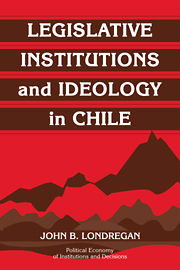Book contents
- Frontmatter
- Contents
- Acknowledgments
- Introduction
- 1 Ideology and Valence
- 2 Accident and Force
- 3 Legislative Institutions in the Constitution of 1980
- 4 Roll-Call Votes and Senate Committees
- 5 The Labor Committee
- 6 The Education Committee
- 7 The Constitution Committee
- 8 Legislative Politics and Chile's Transition Toward Democracy
- Conclusion
- A Estimating Preferences from Voting Records
- Bibliography
- Index
- Titles in the series
3 - Legislative Institutions in the Constitution of 1980
Published online by Cambridge University Press: 22 October 2009
- Frontmatter
- Contents
- Acknowledgments
- Introduction
- 1 Ideology and Valence
- 2 Accident and Force
- 3 Legislative Institutions in the Constitution of 1980
- 4 Roll-Call Votes and Senate Committees
- 5 The Labor Committee
- 6 The Education Committee
- 7 The Constitution Committee
- 8 Legislative Politics and Chile's Transition Toward Democracy
- Conclusion
- A Estimating Preferences from Voting Records
- Bibliography
- Index
- Titles in the series
Summary
Of all of the institutions created by the military government, Chile's Senate is perhaps most influenced by the transition. With its provision for appointed “institutional” Senators to serve side by side with elected members of the chamber, it provides a unique window on the transition. Roll-call voting records from Senate committees make it possible to compare the issue positions of Socialists, with those of Christian Democrats, with members of the Independent Democratic Union (UDI), a party with links to the former military government, and with the positions taken by Senators appointed by Pinochet. Given the Concertación majority in the Chamber of Deputies, and their control of the presidency, the Senate, with its majority for the opposition, acts as a check on the legislative agenda of the Concertación. It is in the Senate that bills are made or broken, and it is the Senate that determines the pace at which policies change and institutions are reformed.
Opposition control of the Senate stands on two pillars: the Institutional Senators and the “binominal” electoral system. The electoral system is based on two-member districts for both the Senate and the Chamber of Deputies. The seats are apportioned according to the d'Hond system, which has the effect of guaranteeing a seat for the party list that finishes second unless its vote share drops below half that of the first-place finisher. After the 1989 elections, this left the opposition with about 42% of the elected seats in each legislative chamber.
- Type
- Chapter
- Information
- Legislative Institutions and Ideology in Chile , pp. 82 - 99Publisher: Cambridge University PressPrint publication year: 2000



